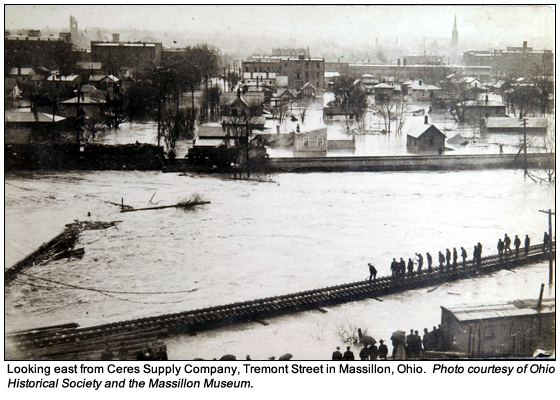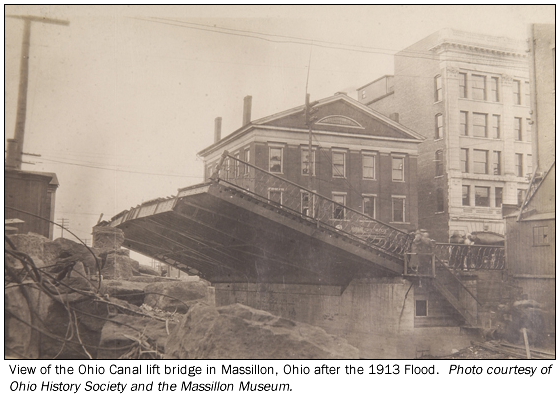The Great Flood of 1913
100 Years Later
Community Profiles: Massillon, Ohio
| River: | Tuscarawas |
| Storm Total Rainfall: | |
| Known Fatalities: |
Timeline/Impacts
The following is provided by Todd Clark, History Programmer and Naturalist with the Stark County Park District.
Stark County & The Flood of 1913
It was March 23, 1913, when the rains began. What would follow, however, quickly proved to be more than an early spring storm. The people of Stark County didn’t know it at the time, but the greatest natural disaster in Ohio’s history began on Easter Sunday… one hundred years ago.
By March 25th, The Evening Independent reported a “one-mile wide torrent” flooded the City of Massillon. The next day the flood waters receded. Those along the routes of the Tuscarawas River and Ohio & Erie Canal began to emerge from their homes and the safety of higher ground. What they found was unlike anything the residents of Stark County had ever witnessed. All along the length of Stark County’s rivers, creeks, and canals the catastrophe had unfolded.
Railroads along the Tuscarawas River were submerged, with engines and cars toppled from their washed out tracks. In Canal Fulton, surging water wrenched the iron bridge crossing the Tuscarawas River at Cherry Street from its foundation. And in Navarre, streetcars sat stranded amidst the flooded city streets. To the north, the City of Akron dynamited a series of canal locks to save the downtown from flooding.
In nearby Massillon, floodwaters breached the banks of the Tuscarawas River and overwhelmed the Ohio & Erie Canal, inundating the downtown and causing substantial flooding for miles around. The wrought-iron Cherry Street Bridge  collapsed, and the Columbia footbridge washed out. Even the impressive lift bridge over the Ohio & Erie Canal on Massillon’s Main Street, the largest lift bridge in Ohio at the time, was impacted by the flood. Dedicated and raised for the first and last time just days before on March 20th, 1913, there was no longer reason to raise the bridge. Extensively damaged by flooding and having steadily lost ground to more modern forms of transportation, the canal that the bridge proudly spanned would not reopen.
collapsed, and the Columbia footbridge washed out. Even the impressive lift bridge over the Ohio & Erie Canal on Massillon’s Main Street, the largest lift bridge in Ohio at the time, was impacted by the flood. Dedicated and raised for the first and last time just days before on March 20th, 1913, there was no longer reason to raise the bridge. Extensively damaged by flooding and having steadily lost ground to more modern forms of transportation, the canal that the bridge proudly spanned would not reopen.
News of the flood spread quickly, although accurate accounts were slow in coming. Massillon’s flooding delayed local news publication, as the printing presses of The Evening Independent were underwater. Reportedly no lives were lost in Massillon, but the local Citizens Relief Committee did raise $45,000 to help flood victims. Not surprisingly, the flood also ruined Massillon’s plans for an Easter parade.
Images from the Flood of 1913 represent the first widely-documented event in Massillon history, recorded by amateur photographers who eagerly captured the scope of this natural disaster. People showed the unprecedented damage done to their communities, homes and businesses, creating a very personal historic record that the Massillon Museum preserves. For many places in and around Massillon, flood photographs are the only documentation of buildings and businesses that once existed. One hundred years later, these images tell the story of The Flood of 1913.
Friends of Stark Parks and the Massillon Museum are partnering to display historic images from the 1913 Flood at the Exploration Gateway in Sippo Lake Park from March 23rd 2013 through December 2013. For more information, visit www.StarkParks.com.

